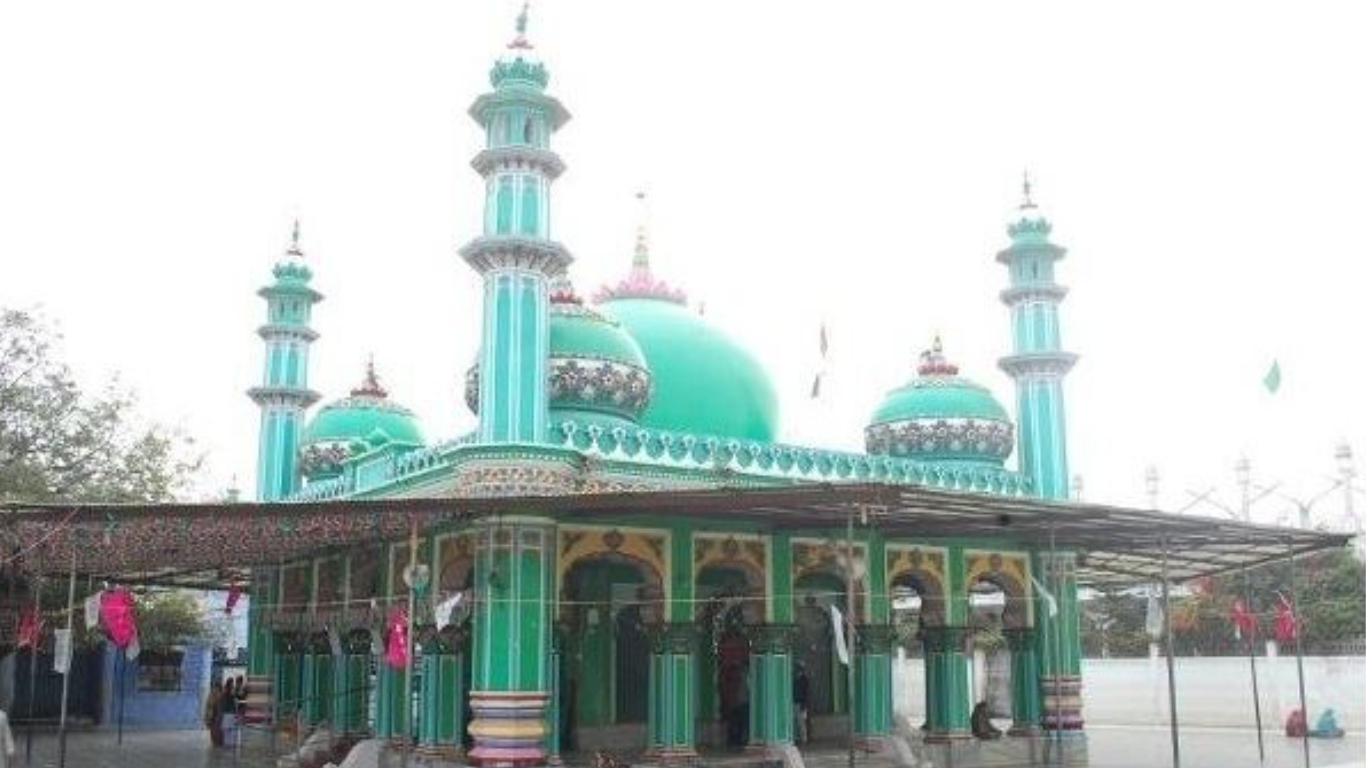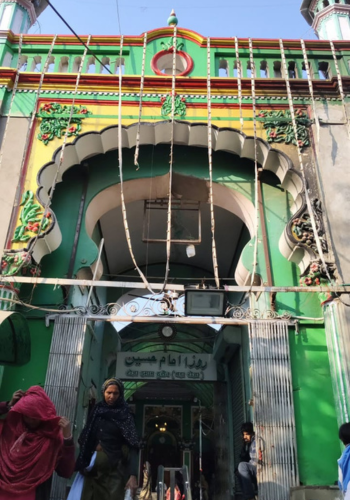The shrine of Hussain Tekri was built in the 19th century by Mohammad Iftikhar Ali Khan Bahadur, the Nawab of Jaora. It is situated on the outskirts of the town of Jaora in the Ratlam district of Malwa region of Madhya Pradesh, India. Mohammad Iftikhar Ali Khan Bahadur was buried in the same graveyard where Hussain Tekri is built. During the month of Muharram, thousands of people visit the shrines of Imam Hussain here, which is a replica of the ones in Iraq. The shrine is known for Hazri rituals intended to cure mental ailments. An unsubstantiated story tells that one night a horse rider were seen at the site of the future shrine; and the riders were said to be the souls of martyrs killed in the Battle of Karbala. It is also believed that a water pond was also created overnight, which never existed before. Barelvis, Shia, Sunnis, and Hindus visit the shrine to get relief from jinns, ghosts and demons, believing that all such creatures ultimately surrender before the shrine and leave the bodies of the victims. This place has a long history of curing people believed to be incurably ill. It has 6 shrines in its vicinity. From the entrance, Fatima Al Zehra (daughter of Mohammed), Imam Al-Hussain (son of Ali), Zainab (daughter of Ali), Al-Abbas (son of Ali), Sakina (daughter of Imam Hussain) and Imam Al-Ali (son of Abu Talib and cousin, son-in-law of Mohammed). Nawab Mohammad Iftikhar Ali Khan Bahadur, Nawab Unman Ali Khan and his younger brother Nawab Usman Ali Khan Tomb are buried in the shrine of Imam Hussain in Hussain Tekri.

Jaora town was a dearest to him; Nawab used to ensure he kept it cleansed twice. In one specific year, during Ashura — 10 Muharram (Islamic celebration) — one day happened coinciding with a rare overlap by Ram Navami of Hindus (celebrations). The Muslim community took their sacred Taziyah through the city to celebrate Hazrat Imam Hussain while a group of Hindu artists, in preparation to enact scenes of the Ramayana.
As the procession of Taziyah began, it held back the Ram Navami artists in the streets that were too narrow and less expansive. It heightened the tension between the two sets of groups. The Nawab permitted the Hindus to lead their procession first following complaints from their side. What happened next was extraordinary. When the Muslims slept near a bonfire, the heavy Taziyah, which required dozens of people to carry, suddenly started floating two meters above the ground. It moved slowly in one direction without any human help. The Hindus who were watching the event ran to tell the Muslim participants, who assembled at the place, amazed at this miraculous scene. It stopped at a place now known as Bazaar Mandi in Jaora.
That night, the Nawab had an elaborate dream with a brilliant holy figure telling him to mark out an area in the adjacent jungle, that was full of the scent of musk. The Nawab, after discussing his dream with the Islamic scholars, decided to take up the divine guidance.
Meanwhile, a leather merchant in Mumbai by the name of Mohammed Ismail was having exactly the same dream. He saw effulgent figure ordering him to construct two shrines inside the boundary as decided by the Nawab. One shrine was to be constructed for Imam Hussain on a hill (Tekri), and the other shrine was to be built in the honor of Hazrat Abbas Alamdaar near a nearby fountain. He didn’t
implement the dream that was given to him at first due to the lack of sufficient money, but soon his business deal delivered some unexpected money. The mystic boy from the dream finally visited Ismail’s office as a reminder and threatened him for the loss of that money. With his warning, the message was more important, as he immediately went to Jaora to build the shrines.
Muharram is the first month of the Islamic calendar and holds immense historical importance. The 10th day of Muharram, known as Ashura, marks the day when Imam Hussain and his followers were brutally martyred after enduring severe deprivation at the hands of Yazid I’s forces.

This event is commemorated through various rituals, including mourning processions, recitations of elegies, and communal gatherings
to reflect on the sacrifices made by Imam Hussain and his companions.During these ceremonies, participants engage in acts of mourning such as wearing black attire, reciting poetry that honors Imam Hussain’s legacy, and participating in processions that often include reenactments of the events at Karbala. The atmosphere is one of solemnity and reflection, emphasizing themes of sacrifice, faith, and moral integrity.
Weekly Ziyarat Schedule
Husain Tekri hosts weekly ziyarat (visits) that allow devotees to pay their respects and seek spiritual
healing. The schedule for these visits typically includes:
• Every Friday:
• Timing: 4 PM – 6 PM IST
• Activities: Recitation of prayers and communal dhikr (remembrance of God).
• Special Healing Rituals:
• Conducted on the first Friday of every month.
• Timing: 5 PM IST
• These rituals are designed to invoke blessings and healing for attendees.
To keep visitors informed about significant events related to Husain Tekri, an updated calendar will be maintained. Here are some key upcoming event:
Date and Event Description
January 15, 2025 Commemoration of the Martyrdom of Imam Hussain
February 1, 2025 Special Healing Rituals
March 10, 2025 Ashura Observances
April 20, 2025 Community Iftar during Ramadan
This calendar will be regularly updated to include additional events as they are scheduled.

A sacred site known for its rich history, spiritual significance, and architectural beauty. A place of devotion and healing, attracting visitors from all over.
© 2025 Husain Tekri. All Rights Reserved.